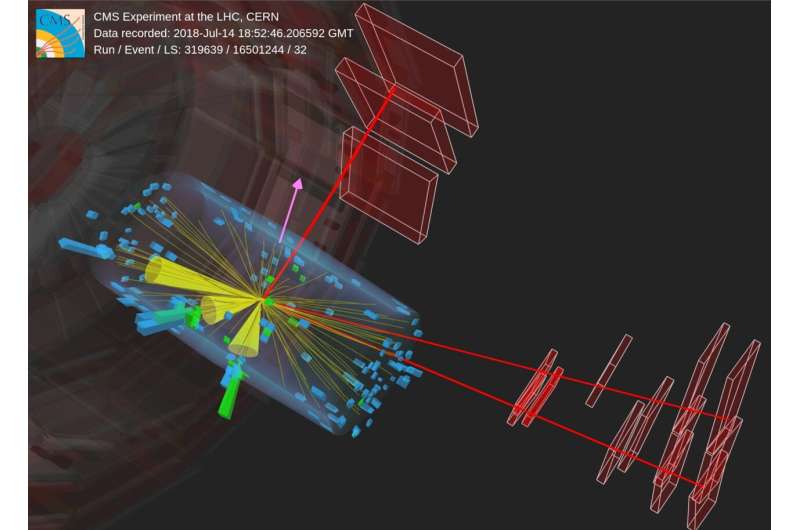Science
CERN Achieves First Observation of Rare tWZ Production Event

On November 3, 2025, researchers at CERN announced the groundbreaking observation of the production of a single top quark alongside a W and Z boson, a phenomenon that occurs only once every trillion proton collisions. This rare event, known as tWZ production, was detected by the Compact Muon Solenoid (CMS) collaboration at the Large Hadron Collider (LHC). The achievement opens new avenues for understanding the fundamental forces of nature and the nature of particle interactions.
Significance of tWZ Production
The detection of tWZ production is significant due to the top quark’s status as the heaviest known fundamental particle, interacting strongly with the Higgs field. Understanding how it interacts with the electroweak force, mediated by the W and Z bosons, could provide insights into the Higgs mechanism. Moreover, researchers believe this observation could indicate new physics beyond the current Standard Model.
Alberto Belvedere, a researcher with the CMS collaboration at DESY, emphasized the challenge of observing such rare events. “Because of its rarity and its similarity with the ttZ process, observing tWZ production requires advanced analysis techniques involving state-of-the-art machine learning,” he stated. The ttZ process, which involves the production of a top and an anti-top quark with a Z boson, occurs approximately seven times more frequently than tWZ production, complicating data analysis due to background noise.
Advanced Analysis Techniques
The CMS collaboration utilized machine learning algorithms to effectively differentiate the tWZ signal from the surrounding background data. The findings revealed that the rate of tWZ production was slightly higher than theoretical predictions. This discrepancy raises questions about whether it is merely a statistical fluctuation or an indication of previously unknown interactions or particles.
“If there are unknown interactions or particles involved, the observed deviation between the measured rate and the prediction would rapidly become larger with increasing energies of the outgoing particles, an effect that is unique to the tWZ process,” said Roman Kogler, another researcher with the CMS collaboration.
For now, this observation marks a pivotal moment in particle physics, highlighting the LHC’s capacity to uncover some of nature’s most elusive secrets. The findings are documented and available on the arXiv preprint server, indicating a new chapter in our understanding of particle interactions.
The CMS collaboration’s work continues to pave the way for future exploration in high-energy physics, with further data analysis expected to clarify the implications of this significant discovery.
-

 Science2 weeks ago
Science2 weeks agoInterstellar Object 3I/ATLAS Emits Unique Metal Alloy, Says Scientist
-

 Politics3 weeks ago
Politics3 weeks agoAfghan Refugee Detained by ICE After Asylum Hearing in New York
-

 Business3 weeks ago
Business3 weeks agoIconic Sand Dollar Social Club Listed for $3 Million in Folly Beach
-

 Health3 weeks ago
Health3 weeks agoPeptilogics Secures $78 Million to Combat Prosthetic Joint Infections
-

 Science3 weeks ago
Science3 weeks agoResearchers Achieve Fastest Genome Sequencing in Under Four Hours
-

 Lifestyle3 weeks ago
Lifestyle3 weeks agoJump for Good: San Clemente Pier Fundraiser Allows Legal Leaps
-

 Health3 weeks ago
Health3 weeks agoResearcher Uncovers Zika Virus Pathway to Placenta Using Nanotubes
-

 World3 weeks ago
World3 weeks agoUS Passport Ranks Drop Out of Top 10 for First Time Ever
-

 Top Stories2 weeks ago
Top Stories2 weeks agoChicago Symphony Orchestra Dazzles with Berlioz Under Mäkelä
-

 Business3 weeks ago
Business3 weeks agoSan Jose High-Rise Faces Foreclosure Over $182.5 Million Loan
-

 World3 weeks ago
World3 weeks agoRegional Pilots’ Salaries Surge to Six Figures in 2025
-

 Entertainment3 weeks ago
Entertainment3 weeks agoJennifer Lopez Addresses A-Rod Split in Candid Interview









